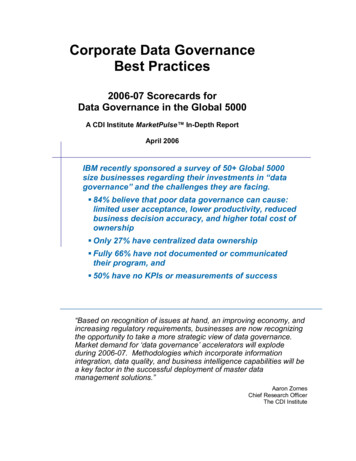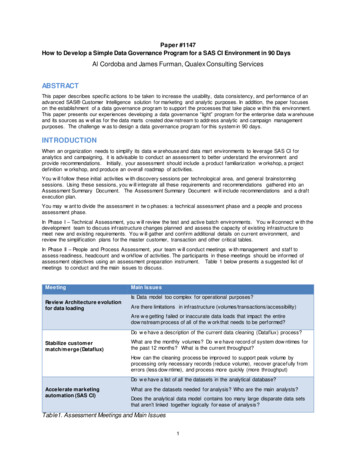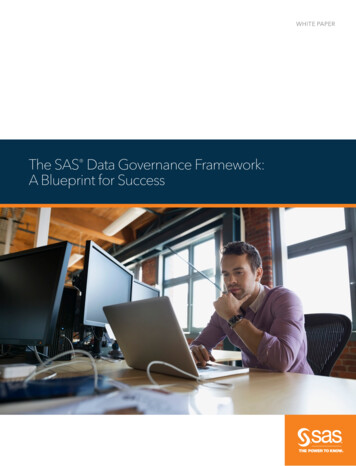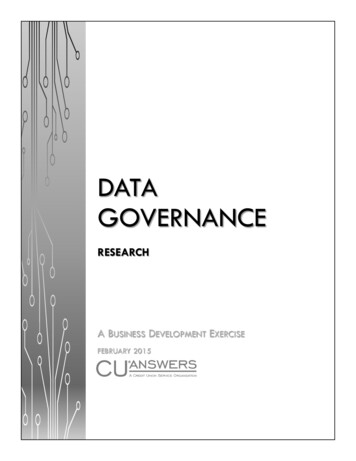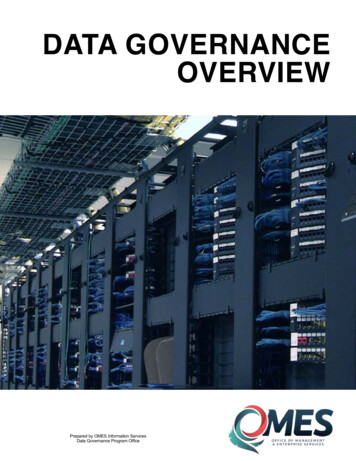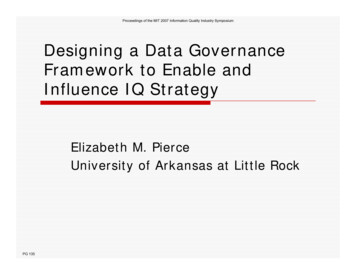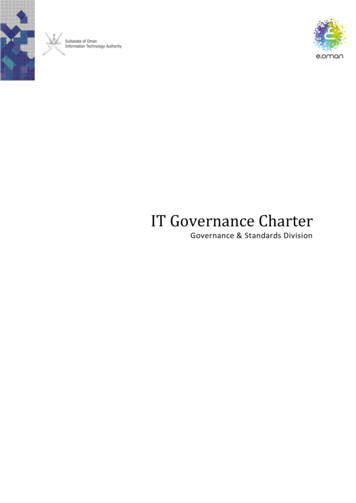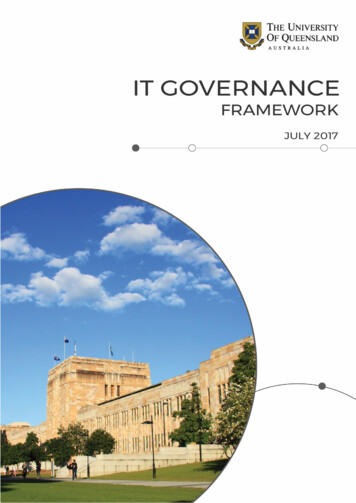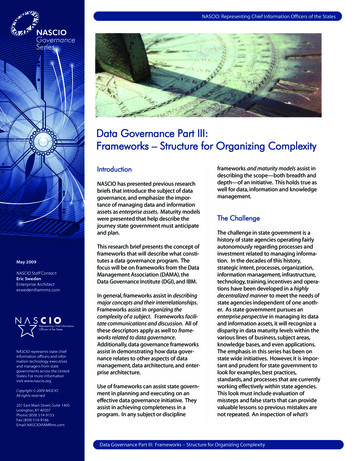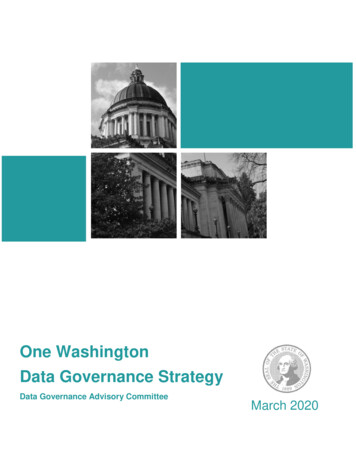
Transcription
One WashingtonData Governance StrategyData Governance Advisory CommitteecMarch 2020
One Washington is a comprehensive business transformation program to modernize andimprove the state’s aging enterprise core business systems. Data, as a valuable state asset, is aparamount component in this transformation.OneWa has created a data governance advisory committee with representation from stateenterprise business owners and agency partners to oversee the enterprise data work the statewill be doing as we move toward an integrated software solution. The committee is responsiblefor recommending policies, guiding principles, guardrails and best practices to higher-levelcommittees to ensure state data is maintained as an enterprise asset and that there areprotections in place for OneWa to work safely within. (Diagram 1.1)Diagram 1.1Employing this strategy will help improve the quality, transparency and usability of the state’senterprise data by providing a framework for strong and deliberate data governance.(Data Governance Strategy)Page 2
OverviewData governance is defined as the exercise of authority and control (planning, monitoring andenforcement) of the management of data assets. (DAMA DMBOK) It defines and oversees theavailability, usability, integrity and security of the data employed in an enterprise.Management of data assets refers to the development, execution and supervision of plans,policies, programs and practices that deliver, control, protect and enhance the value of thoseassets throughout their lifecycle.DAMA InternationalDiagram 1.2This diagram, (diagram 1.2) illustrates that data governance, as the hub of data management, isresponsible for guiding all of the other functional ‘spokes.’ As with any wheel, it is only asstrong as its hub, stressing the importance of data governance overall. (DAMA DMBOK)The OneWa data governance advisory committee will place an emphasis on setting guidingprinciples and guardrails (diagram 1.3) around: Data ownership and stewardship - owners set the rules around the data they areresponsible for, assigned data stewards help enforce the rules. Data access and usage – defining who can access data and how that data can be used.(Data Governance Strategy)Page 3
Data integrity – assurance of complete, accurate and consistent data. Data integration – what, where, why and how data moves from one place to another. Data security – ensures enterprise data is always protected at the appropriate levels. Data accessibility – data is easily and readily available to all authorized users. Data standardization – helps transform enterprise data into a consistent format, makingit easier to analyze and turn into actionable insights. Data transparency – ability to easily access complete and accurate data. Data risk management – identifying and mitigating risks while ensuring compliance withapplicable policies, laws and standards.Guiding PrinciplesA set of general rules that help the program team and governance members make the rightdecisions when faced with a choice. They are rarely amended and are used to inform andsupport the manner in which an organization sets about fulfilling its mission.GuardrailsGuardrails are rules intended to help the program team and governance members make high–quality decisions faster and with less risk. They are designed to keep projects fromunintentionally straying into dangerous territory as well as to support greater alignmentacross an organization by providing a context for understanding the business needs.TacticsAssessments that consider both short and long term needs when describing how the state willimplement an ERP solution across the major business functions for finance, procurement,budget, human resources and payroll. They evolve from guardrails and provide detailedtactics to follow during implementation.Diagram 1.3It is crucial that the guardrails are in place by the end of the readiness phase in preparation forthe design phase. As the state moves forward into design and implementation, the datagovernance advisory committee will be available to answer questions and/or help resolveconflict, as necessary.(Data Governance Strategy)Page 4
Guiding PrinciplesThese are the data management principles that OneWa follows at the enterprise level. Agenciesare encouraged to develop and maintain an appropriate set of principles. Enterprise data is managed as a state asset.Enterprise data is secure.Data is shared across enterprise functions and processes.Data is accessible for authorized users to perform their functions.Future state policies, procedures and processes regarding data, are standardized andsimplified to ensure substantial productivity gains across the enterprise.Enterprise data has common vocabulary, definitions and metadata.Data is owned by business and has a named owner.Data owners are defined by subject area, enterprise agreement or other agreed uponmethod.Data owners define the business rules for their data.Data owners set the standards for their data.Data owners define who can access their data.Data owners assign data stewards.Data owners are responsible for the quality of their data.There is only one system of record for each specific data element.GuardrailsThese are the enterprise-level guardrails that OneWa adheres to. Agencies are encouraged todevelop and maintain an appropriate set of guardrails in the management of their data.Data GovernanceThe exercise of authority, control and shared decision-making (planning, monitoring andenforcement) over the management of data assets Data critical to each business function will be identified and fully documented.Data stewards will be named and assigned to all business critical data elements.Data ArchitectureThe development of the core data architecture within the context of the state enterprise Data definitions will be unambiguous, understandable and available to all users.A glossary with common vocabulary/terminology and taxonomy will beestablished, to avoid misinterpretation of data.(Data Governance Strategy)Page 5
A data dictionary that provides a concise guide to understanding and using thedata, for each element or variable in the dataset and data model, will be createdand maintained.Establish one data dictionary for multiple purposes (data usage, design,requirements, conversion, formats, values, quality indicators, etc.)Data DevelopmentThe data-focused activities within the system development lifecycle, including data modelingand data requirements analysis, design, implementation and maintenance of databases anddata-related solution components Limitations of the data will be identified and documented to prevent unintendeduse or overuse.The business needs for the data (i.e. business requirements) will be clearlyarticulated.Data will be easily accessible to approved users.Data movement and copies of data will be minimized whenever possible.Data SecurityPlanning, implementation and control activities to ensure privacy and confidentiality and toprevent unauthorized and inappropriate data access, creation or change A roles matrix based on access rules and security restrictions will be built out andmaintained.Data QualityPlanning, implementation and control activities that apply quality management techniques tomeasure, assess, improve and ensure the fitness of data for use Converted data must come from trusted systems of record with consistentdefinitions.Source system owners are responsible for data cleansing and the prevention ofconversion data issues.What constitutes quality data from a business perspective must be documentedduring the design phase.Data quality efforts must be staffed appropriately - data stewards will have amajor impact on the quality and perception of ERP implementation success.Master Data ManagementPlanning, implementation and control activities to ensure consistency of contextual datavalues with a “golden version” of these data values(Data Governance Strategy)Page 6
Understand that MDM is business-driven and technology enabled - datastewards will develop master data definitions, processes and policies based onbusiness needs.Business owners are responsible for identifying master data within their subjectarea(s).Metadata ManagementPlanning, implementation and control activities to enable easy access to high quality,integrated metadata that helps users understand the meaning and content of dataDevelop a metadata strategy to include: Standard metadata schemas and formats are used to avoid misinterpretation ofinformation.A single source of specific metadata types to avoid multiple metadata sources.Assigned responsibilities for maintaining specific types of metadata.A detailed plan to maintain the metadata repository/data dictionary.Metadata that is easily accessible to appropriate users.TacticsTactics will be included in a different document as they are identified by the program duringthe planning and design phase. That document will be named and/or linked from here onceit is created.This is a living document and information may be added or adjusted as the program progressesand more facts become available. If you have questions or concerns, please contact the OneWamailbox at OneWA@ofm.wa.gov.(Data Governance Strategy)Page 7
GlossaryData governance – active and deliberate decision-making and authority for data-relatedmatters. Data governance defines how an organization makes decisions around their data.Legacy system – for this undertaking, we are defining a legacy system as any existing agencyand/or enterprise system that has been identified to be replaced by the new enterprise systemor any existing agency system that will integrate (send or receive data) with the new system.Best Practices and Agency Roles for Effective Data ManagementAgency finance, procurement, budget,HR and payroll teamsData owner – responsible for the risk, quality andappropriate access to data. Since data is ownedby the business, in most cases the owner of thebusiness function and the data owner are thesame. Ownership can be transferred to anotherdata/business owner if both parties agree.Changes in ownership should be documentedand entered into the enterprise data catalog.Data stewards - business subject matter expert.Represent the Data Owner and are responsiblefor data quality, data definitions, business rulesand data usage.(Data Governance Strategy)Page 8Agency information technology teamData custodians - responsible for the technicalside of data including security, accuracy, recoveryand business rule implementation. This is usuallyyour database administrator or systemadministrator.
(Data Governance Strategy) Page 4 Data integrity - assurance of complete, accurate and consistent data. Data integration - what, where, why and how data moves from one place to another. Data security - ensures enterprise data is always protected at the appropriate levels. Data accessibility - data is easily and readily available to all authorized users.

